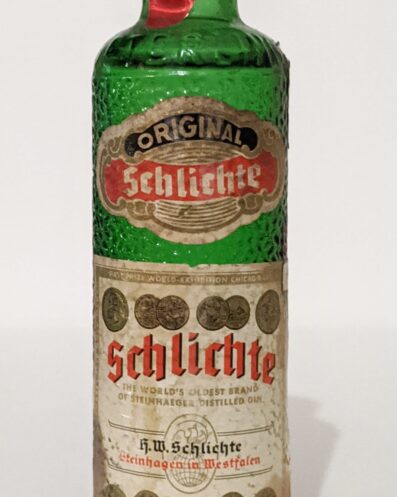Schlichte Gin is one of a few extant examples of Steinhager, an extant protected category of juniper flavored spirit beverage (still protected under the 2019 regulation).
Though said to be based on a fifteenth/sixteenth century recipe, Schlichte did not appear on the American scene until the 1980’s when the first importer began bringing it over. The 1980s version is bottled at 40% ABV, whereas the modern import strength is 38%.
The bottle we’re reviewing is the 1980’s American version. It includes a state of Wisconsin import sticker on it. Similar to other antique spirits we’ve reviewed, keep in mind that while the spirit itself may be different, storage conditions may adversely affect the spirit inside. We review these for reference, for collectors and bartenders who are considering acquiring these spirits— and maybe even serving them.
Tasting Notes
The cap was securely sealed under a foil pull-off. The plastic popped off with a satisfying noise— there appears to be no evaporation and the seal remained tight.
Surprisingly more vivid than the current 38% ABV export strength. 1980’s Schlichte is far more recognizable as a gin. Terpey, slightly piney juniper with a vanilla red winter wheat note. Very clean.
Unfortunately, the palate is where some of the storage concerns emerge. There’s a lot more heat with a crisp vegetable and juniper character. Plastic and medicinal notes are overwhelming on the mid-palate. The finish has an earthy juniper flavor, strongly suggestive of Borovicka.
Long piney finish with residual notes of petroleum jelly and grain spirit.
Overall, Schlichte Gin (1980’s)
I had high hopes for this one. The seal seemed perfect. However, similar to others of this era and earlier, there’s off notes that are likely the result of improper storage or low-quality plastics used in the construction of the stopper.
Again— let this be a reminder. Buyer, beware. Antique Spirits sound romantic; however, except in very rare instances bottle construction and storage often transmute spirits and distort the distiller’s original intentions.
Even as a historical note, this sample of Schlichte Gin from the 1980’s is of little interest to gin historians— aside from the peculiarity of having a different bottled strength than the currently available version.


I have a similar bottle, but the only English word is “original” at the very top, everything else is German, I believe. Are these worth more than the English/American version?